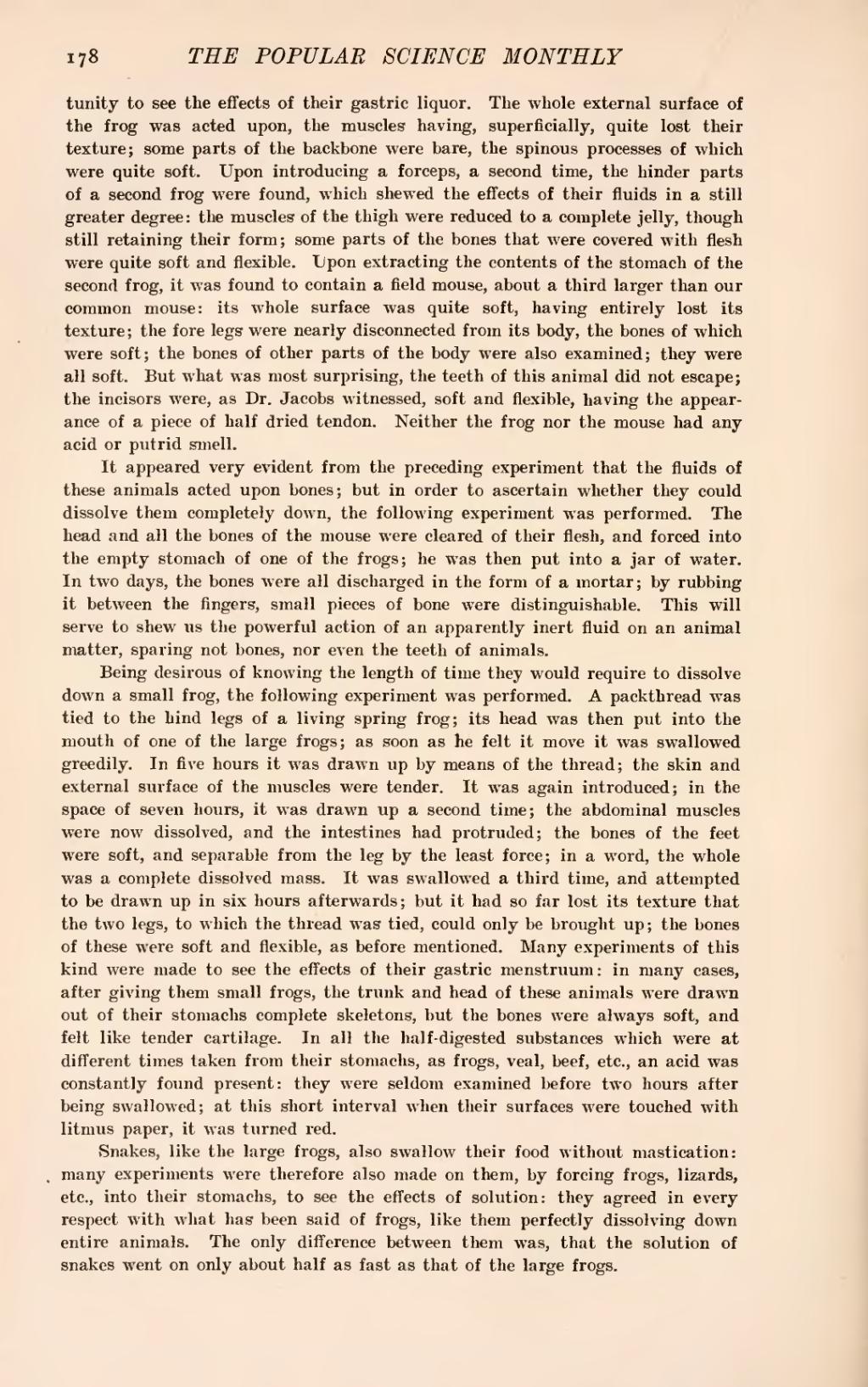tunity to see the effects of their gastric liquor. The whole external surface of the frog was acted upon, the muscles having, superficially, quite lost their texture; some parts of the backbone were bare, the spinous processes of which were quite soft. Upon introducing a forceps, a second time, the hinder parts of a second frog were found, which shewed the effects of their fluids in a still greater degree: the muscles of the thigh were reduced to a complete jelly, though still retaining their form; some parts of the bones that were covered with flesh were quite soft and flexible. Upon extracting the contents of the stomach of the second frog, it was found to contain a field mouse, about a third larger than our common mouse: its whole surface was quite soft, having entirely lost its texture; the fore legs were nearly disconnected from its body, the bones of which were soft; the bones of other parts of the body were also examined; they were all soft. But what was most surprising, the teeth of this animal did not escape; the incisors were, as Dr. Jacobs witnessed, soft and flexible, having the appearance of a piece of half dried tendon. Neither the frog nor the mouse had any acid or putrid smell.
It appeared very evident from the preceding experiment that the fluids of these animals acted upon bones; but in order to ascertain whether they could dissolve them completely down, the following experiment was performed. The head and all the bones of the mouse were cleared of their flesh, and forced into the empty stomach of one of the frogs; he was then put into a jar of water. In two days, the bones were all discharged in the form of a mortar; by rubbing it between the fingers, small pieces of bone were distinguishable. This will serve to shew us the powerful action of an apparently inert fluid on an animal matter, sparing not bones, nor even the teeth of animals.
Being desirous of knowing the length of time they would require to dissolve down a small frog, the following experiment was performed. A packthread was tied to the hind legs of a living spring frog; its head was then put into the mouth of one of the large frogs; as soon as he felt it move it was swallowed greedily. In five hours it was drawn up by means of the thread; the skin and external surface of the muscles were tender. It was again introduced; in the space of seven hours, it was drawn up a second time; the abdominal muscles were now dissolved, and the intestines had protruded; the bones of the feet were soft, and separable from the leg by the least force; in a word, the whole was a complete dissolved mass. It was swallowed a third time, and attempted to be drawn up in six hours afterwards; but it had so far lost its texture that the two legs, to which the thread was tied, could only be brought up; the bones of these were soft and flexible, as before mentioned. Many experiments of this kind were made to see the effects of their gastric menstruum: in many cases, after giving them small frogs, the trunk and head of these animals were drawn out of their stomachs complete skeletons, but the bones were always soft, and felt like tender cartilage. In all the half-digested substances which were at different times taken from their stomachs, as frogs, veal, beef, etc., an acid was constantly found present: they were seldom examined before two hours after being swallowed; at this short interval when their surfaces were touched with litmus paper, it was turned red.
Snakes, like the large frogs, also swallow their food without mastication: many experiments were therefore also made on them, by forcing frogs, lizards, etc., into their stomachs, to see the effects of solution: they agreed in every respect with what has been said of frogs, like them perfectly dissolving down entire animals. The only difference between them was, that the solution of snakes went on only about half as fast as that of the large frogs.
